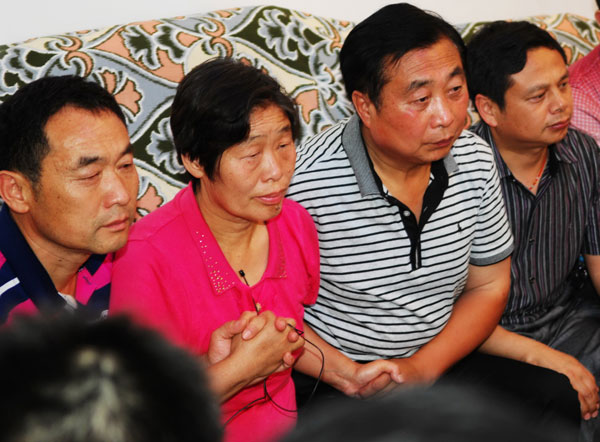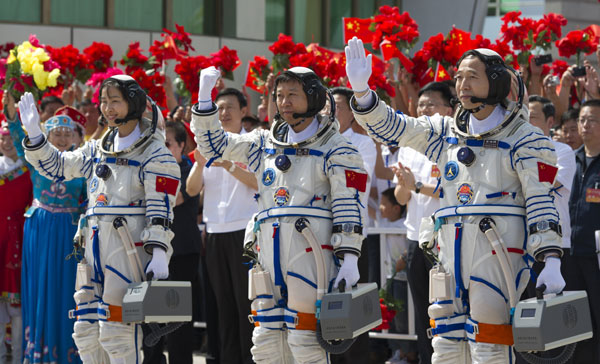China sends first female astronaut into space
Updated: 2012-06-17 07:20
By Xin Dingding in Jiuquan, Gansu and Wang Qian in Beijing (China Daily)
|
||||||||
Back in Zhengzhou, Henan province, up to a hundred media people swarmed into Liu Yang's home to see her parents and relatives watching the live broadcast of the launch. In the residential community, a large LED screen was set up on Saturday afternoon, drawing hundreds of people to view the launch.
"Daughter, I love you," a relieved Niu Xiyun, Liu's mother, said right after the launch. "You are the flower in my heart."
"My wish is that she and all of the crew finish the mission successfully," said her father, Liu Shilin.
 |
|
Watching the launch of the rocket on TV is a proud but nervous moment for the parents of Liu Yang, China’s first female astronaut (mother Niu Xiyun, second left, and father Liu Shilin, second right). [Photo by Xiang Mingchao/China Daily] |
In about two days, the spacecraft will conduct a robotic docking with Tiangong-1 and astronauts will move to the space lab module and conduct scientific experiments.
For them, the challenges ahead are tough, including conducting the country's first manual docking and living in weightlessness for the longest time in China's space history.
According to the plan, the manual docking is scheduled for the middle of the mission. Astronauts will maneuver the spacecraft close to Tiangong-1 - both moving at a speed of 7.9 km per second - in a limited time and with minimal fuel consumed.
Though the astronauts have practiced manual docking for more than 1,500 times each, their performance is subject to huge pressure and the zero-gravity environment, said Chen Shanguang, head designer of the astronaut system.
"It is a huge test for astronauts' ability to judge spatial position, eye-hand coordination and psychological abilities," he said.
History shows space dockings have high risks.
The United States and Russia (the former Soviet Union) have conducted more than 300 docking missions since 1966. Among them, the US has failed twice, while Russia (the former Soviet Union) has failed 15 times. Most of these failures happened in the initial stages of their space exploration.
China plans to send three spacecraft to rendezvous and dock with the orbiting Tiangong-1 space lab module. Last November, China achieved a robotic docking between unmanned Shenzhou VIII and Tiangong-1.Zhou Jianping, chief designer of the manned space program, said that China needs to conduct multiple missions to test its ability in space rendezvous and docking, a key technology for assembling a space station.
"One successful mission does not mean all similar missions will be successful, because the space docking results could vary due to different types of space vehicles and different space environment. So carrying out multiple spaceflights will enhance the maturity and reliability of China's space docking technology," he said.
Another big challenge astronauts will face is the zero-gravity environment, in which they will stay for more than 10 days, longer than the past three manned missions combined.
Mission commander Jing, who stayed in space for three days in 2008, said that living in weightlessness feels like standing on one's head.
"You feel the blood has all gushed to the head. The head and the eyes feel swollen, and the nose seems to get stuck. On the Earth, many people can stand upside down for just a few minutes," he said. The crew will experience that sensation for more than 10 days.
Research showed that human beings in weightlessness usually suffer fluid redistribution, bone and muscle loss and space-motion sickness that can cause dizziness and nausea.
Astronauts returning from long-duration space missions are also likely to suffer orthostatic intolerance, which means they feel dizzy when they try to stand up from a lying posture after returning to Earth.
Female astronauts are more likely to develop the intolerance and will usually take a longer time to recover than their male counterparts, Chen said.
The three astronauts may not be able to walk out of the spacecraft's re-entry capsule because of this condition after landing in the central part of the Inner Mongolia autonomous region in late June, he said.
"We will simplify the welcoming ceremony for the returning astronauts. When they return, they will be escorted to Beijing for recovery in a lying or sitting posture," he said.
Contact the writers at xindingding@chinadaily.com.cn and wangqian@chinadaily.com.cn
An Baijie in Zhengzhou contributed to this story.
- Hu celebrates Shenzhou IX launch
- Live Report
- Shenzhou IX astronauts ready for launch
- Lauching tower of Shenzhou IX spacecraft
- UN official praises development of China's space program
- China launches spaceship with first female astronaut
- China holds see-off ceremony for astronauts
- Liu Yang, China's first female astronaut

 Relief reaches isolated village
Relief reaches isolated village
 Rainfall poses new threats to quake-hit region
Rainfall poses new threats to quake-hit region
 Funerals begin for Boston bombing victims
Funerals begin for Boston bombing victims
 Quake takeaway from China's Air Force
Quake takeaway from China's Air Force
 Obama celebrates young inventors at science fair
Obama celebrates young inventors at science fair
 Earth Day marked around the world
Earth Day marked around the world
 Volunteer team helping students find sense of normalcy
Volunteer team helping students find sense of normalcy
 Ethnic groups quick to join rescue efforts
Ethnic groups quick to join rescue efforts
Most Viewed
Editor's Picks

|

|

|

|

|

|
Today's Top News
Health new priority for quake zone
Xi meets US top military officer
Japan's boats driven out of Diaoyu
China mulls online shopping legislation
Bird flu death toll rises to 22
Putin appoints new ambassador to China
Japanese ships blocked from Diaoyu Islands
Inspired by Guan, more Chinese pick up golf
US Weekly

|

|







